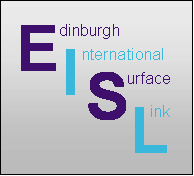 |
Edinburgh International Surface Link
Outline proposals for review and comment |
||||||||||
| Home | EARL, Gogar and trams | Development and objectives | EISL A | EISL B | Conclusions | About |
|
In 2001, the Scottish Government, in association with BAA (the then owner of Glasgow and Edinburgh airports), Scottish Enterprise, the Strategic Rail Authority and the Department for Transport, commissioned consultants to carry out a detailed economic and engineering study on the options to link Glasgow and Edinburgh Airports to the rail network.
The
consultants’ report was published in February 2003 and its conclusions concerning the link to Edinburgh airport included (Section 8.5.3):
“….the Surface Diversion option would offer the best value for money. However, this option would impose a significant time delay to passengers using the services diverted into the Airport (10 minutes to Stirling and 15 minutes to Fife). The next best option is the Runway Tunnel option although, under base case assumptions, the value for money would be appreciably lower than that for the Surface Diversion option.
“…Our financial appraisals have shown that, while it would be difficult to attract private sector investment in the Runway Tunnel option, it may be possible to make the Surface Diversion option sufficiently attractive for significant private sector involvement. As matters stand, and under neutral assumptions, the Runway Tunnel option could only be taken forward with a large public sector funding contribution.”
Following the report’s publication, the Scottish Government, in association with BAA, announced its commitment to further development of the proposals for a link to Edinburgh Airport. The Scottish Government appointed tie ltd, which was owned by the City of Edinburgh Council, to develop the proposals for the Edinburgh Airport Rail Link (EARL). The Runway Tunnel option was adopted for development. The non-technical summary of the Environmental Statement contains a helpful explanation of the proposals.
The EARL project was progressed through to an Act of Parliament for which Royal Assent was granted on 19 April 2007. However, on 27 June 2007, following the change of Government in May, the Scottish Parliament passed a motion which, among other matters, called on the Scottish Government to resolve
“… the governance issues identified by the Auditor General before any binding financial commitment is made and to report back to the Parliament in September on the outcome of its discussions with the relevant parties.”
Transport Scotland asked tie to suspend active work and expenditure on implementing the project pending the outcome of the review process.
|
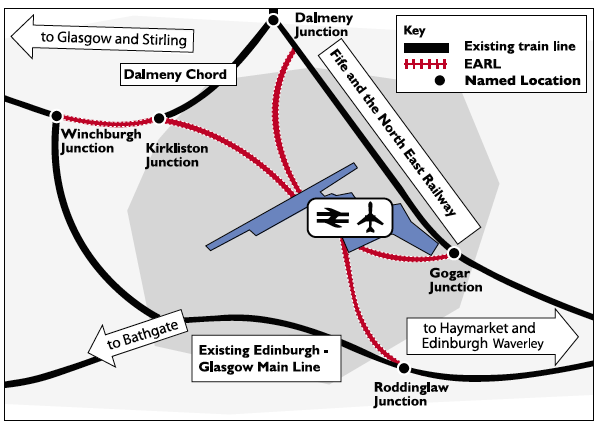
EARL schematic 
EARL plan 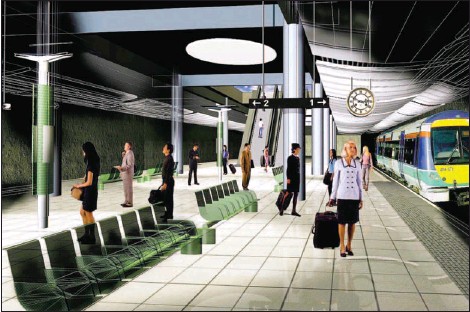
EARL station |
Government plans for Edinburgh Gateway and the Almond chordOn 27 September 2007 the Minister for Transport, Stewart Stevenson MSP, announced:
“There is simply no sensible way for EARL to proceed in its original form…….The EARL project proposed:
The Minister instead proposed an alternative solution of adding an airport station at Gogar on the Fife railway line. This would provide an interchange with Edinburgh City’s trams for onward travel to the airport. He also said that the Government intends to build a rail link between the Fife and the Edinburgh & Glasgow (E&G) routes – the Almond chord – that would allow E&G trains to stop at the new airport station. (The terminology in 2007 was 'the Dalmeny chord' but that created confusion with the existing rail link between Winchburgh junction and Dalmeny junction which already carries that name so we refer to 'the Almond chord' throughout to refer to the proposed new link.) The layout of the railway lines in 2007 and the assumed configuration of the proposed Edinburgh Gateway station and Almond chord are shown in Figure 1. There were no plans or documentation available in the public domain in 2007 that provided details or layouts of the Government’s proposals. The station at Gogar later came to be named 'Edinburgh Gateway' and serves only the northern two of the four railway tracks that pass through Haymarket and Waverley. Trains to and from Fife use the northern pair of tracks; trains to and from Glasgow, Falkirk and Stirling use the southern pair. Therefore, trains to and from Glasgow that serve Edinburgh Gateway station via the proposed Almond chord would share the northern pair of tracks with Fife trains. The requirement for the Almond chord appears unrelated to Edinburgh Airport. Prior to the Airdrie-Bathgate line being reopened in 2010, four trains per hour (tph) ran from Glasgow Queen Street, via Falkirk and Newbridge Junction to Edinburgh Waverley and a further two tph ran between Dunblane and Edinburgh. Network Rail has since electrified and increased the capacity of the E&G line as part of the EGIP project. With the addition of 4tph from Glasgow via Bathgate and a further 2tph from new services via Cumbernauld, there will be a total of twelve tph to be accommodated on the E&G line through Newbridge junction and Edinburgh Park. The current track configuration cannot cope easily with this traffic. Newbridge junction is a flat junction and it would not be practicable to rebuild it as a grade-separated junction because it spans the M8 motorway, as shown in Figure 2. The initial technical feasibility report on the reopening of the Airdrie-Bathgate line noted (Section 3.1.1) “If EARL should proceed…it would ease the well-known capacity constraints at and east of Newbridge Junction into Haymarket Station.” In the absence of EARL (or either EISL proposal), the Almond chord is required to provide the opportunity to divert some of the trains from Glasgow (via Falkirk) onto the Fife lines. The Fife lines carry only five or six tph and Network Rail has upgraded the signalling to improve their capacity. Diverting some of the Glasgow (via Falkirk) trains onto the Fife lines via Dalmeny would balance the loading on the E&G and the Fife lines more evenly and provide operational flexibility to cope with disruption to services. It would enable more trains to be timetabled to stop at Edinburgh Park. It is possible that the opening of the Almond chord would reduce the number of trains that could stop at Edinburgh Gateway because the tracks through that station would then be required by a greater density of traffic and trains that stop would delay following non-stopping trains. All trains that use the Fife lines will pass through Edinburgh Gateway, regardless of whether they are stopping there. This is a different arrangement from that which was proposed for EARL, in which an extra set of tracks would have been provided forming a loop that would be used only by trains stopping at the airport station. EARL proposed only two platforms and proposed a timetable that allowed only about half the trains from the Fife lines and half from the E&G lines to be diverted through the EARL loop, because the EARL station’s two platforms could not have coped with all the trains that travel west from the four platforms at Haymarket. Likewise, Edinburgh Gateway could never have more than about half the trains heading west from Haymarket passing through it, and fewer if many trains are to stop at Edinburgh Gateway. Because all Fife-bound trains must pass through Edinburgh Gateway, this will limit the number of trains that can use the proposed Almond chord. It is not obvious how many trains per hour could stop at Edinburgh Gateway but it appears unlikely that frequent services can be offered to any part of Scotland that is not served by a rail line through Fife. With the Almond chord operational, the arrangements at Edinburgh Gateway and Edinburgh Park would be complex for passengers, especially infrequent travellers or tourists arriving at the airport. For example, it would be complex to advise passengers travelling from the airport where they should alight from the tram to board a train to Falkirk. The next train may leave from either Edinburgh Gateway or Edinburgh Park. The station at Edinburgh Gateway directly benefits only passengers travelling from Fife, who are able to transfer to a tram at Edinburgh Gateway, rather than at Haymarket. It is unlikely to provide more than two trains per hour for passengers travelling to or from Glasgow. It will be unable to serve the Airdrie – Bathgate line to Glasgow. The Almond chord would offer benefits to the rail network but not directly to passengers travelling to or from Edinburgh Airport.
In 2007 we wrote:
"If the option of developing EISL is to be taken forward, or at least preserved as a development option, it would be preferable for the Government to agree that:
|
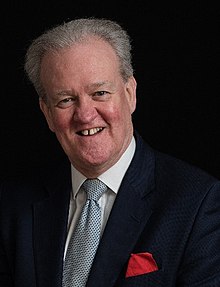
Stewart Stevenson MSP 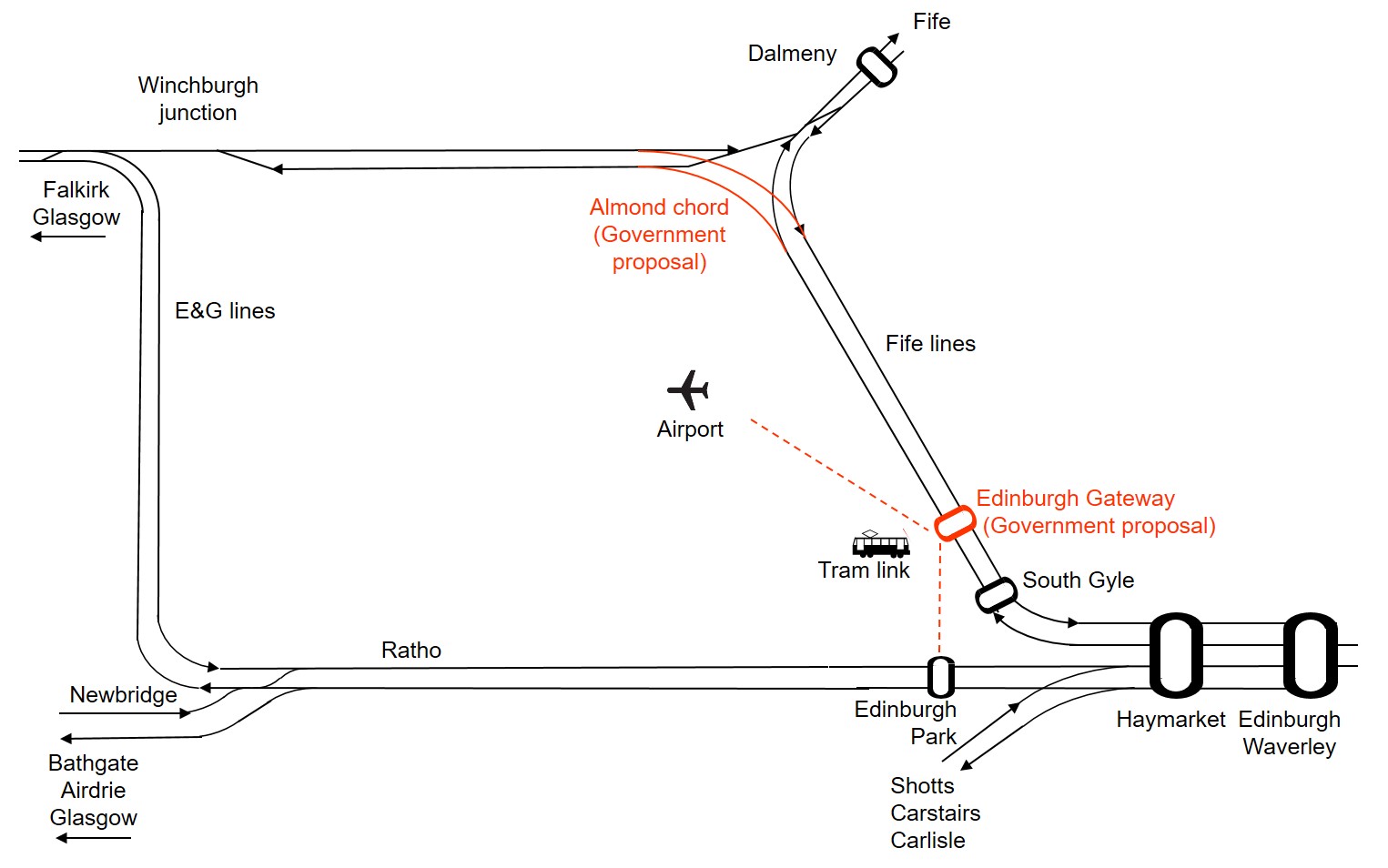
2007 proposals: Almond chord and Edinburgh Gateway 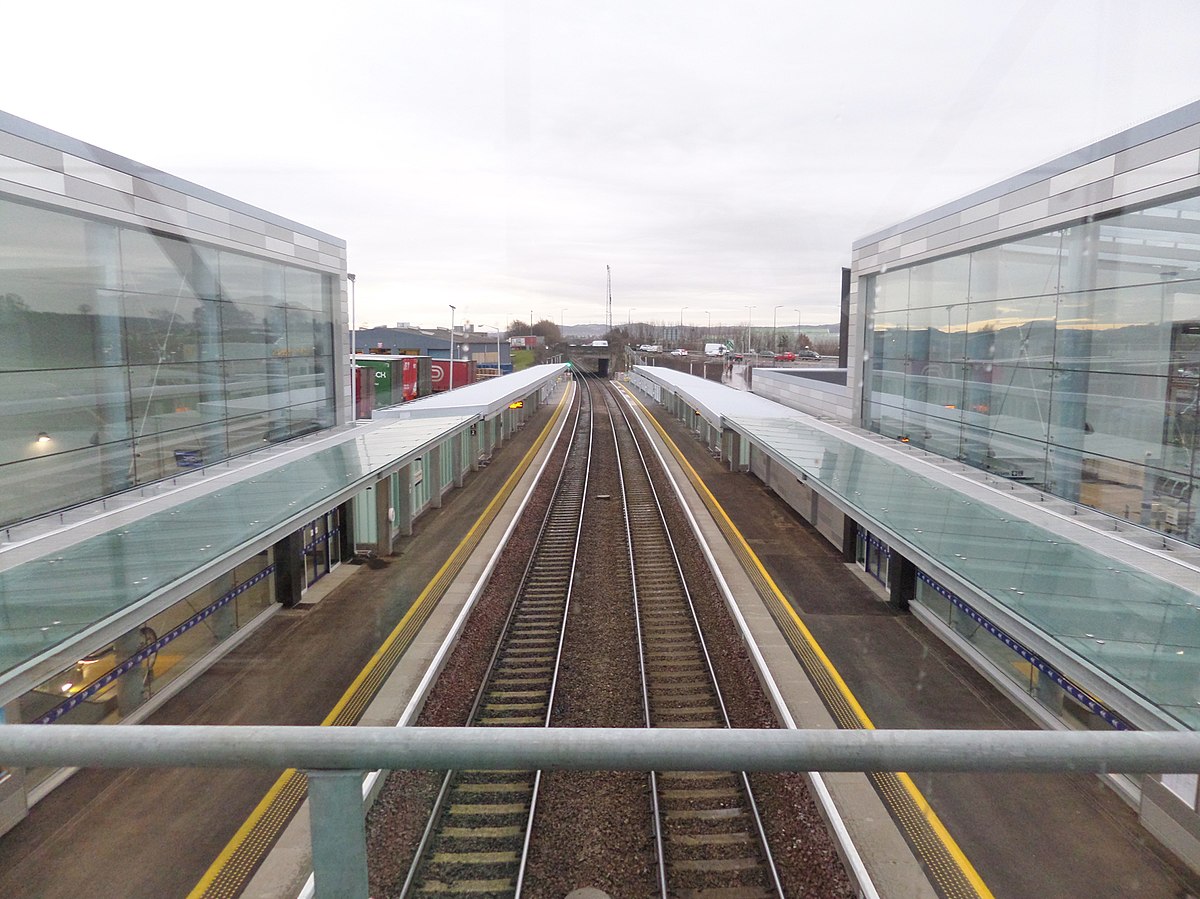
Edinburgh Gateway station (2016) 
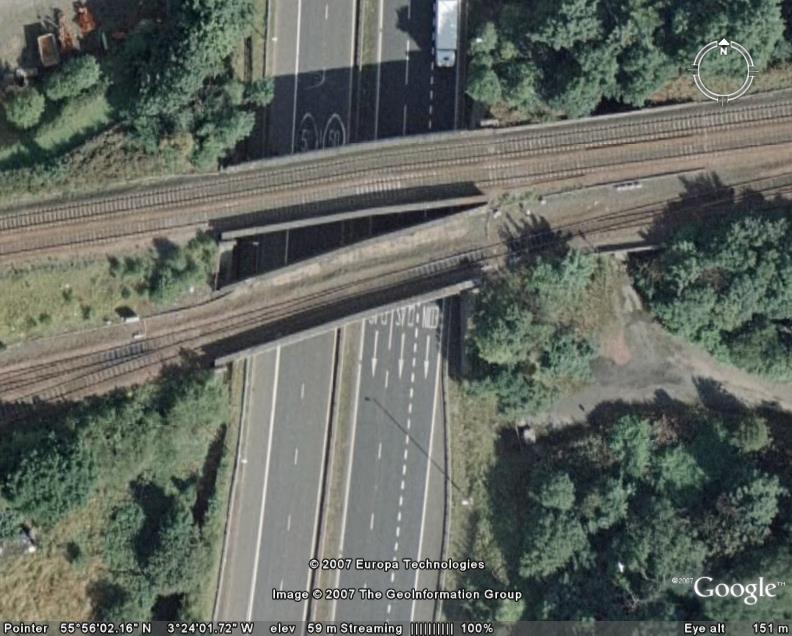
Newbridge junction (spanning M8 motorway) |
Edinburgh tramsThe Edinburgh tram project was conceived in 2003. It included three phases with a total cost of £375 million. Following political disagreements, funding was secured and endorsed by the Scottish government in 2007. However, subsequent revisions to the project led to increases in the total costs to £498 million in 2007 and then to £776 million, with a reduction in the scope of works to Phase 1a only, from the Airport to Newhaven (Leith). The project was beset by contractual disputes and poor client oversight and governance, which remains (2018) the subject of an Inquiry chaired by Lord Hardie. The whole budget was spent but only part of Phase 1a was completed, from the Airport to York Place in the City Centre. The intention in 2011 was for a frequent service from Leith, through the centre of Edinburgh, to the airport, as shown in Figure 3. The business case for the trams indicated six trams per hour on the route to the airport. The trams call at Haymarket station and Edinburgh Park station en route to the airport. The Government’s subsequent proposal for and funding of the new Edinburgh Gateway station includes an additional interchange with the trams at that station also. Figure 4 is an aerial view from 2007 of the western end of the route. This was plotted using the drawings that were made publicly available at www.tramtime.com (since taken down). It shows the line passing to the south of Edinburgh Park station and crossing the E&G line on a viaduct. The line passes through Edinburgh Park to the Gyle shopping centre where the 2005 amendments to the route now take it parallel to the road south west of the car park. From there, the tram line enters a tunnel under the A8 road to emerge north of the A8 by the tram depot. The line then travels west to Gogar burn, and on to the Ingliston Park & Ride and the airport. When these EISL proposals were developed in 2007, there were no drawings evident in the public domain that showed the Government’s proposal for a tram-train interchange at Edinburgh Gateway. It was not obvious where the station would be sited nor whether an additional or relocated tram stop would be provided. The tram line is very steep where it passes under the A8, with gradients of 1:17. It was not obvious how this interchange would be provided and the subsequent design for Edinburgh Gateway proved to be complex and costly. In 2007, we (wrongly) assumed that the station would be south of the A8 road to enable passengers to use the currently planned tram stop at Gyle. |

Tram plans: Phases 1 - 3 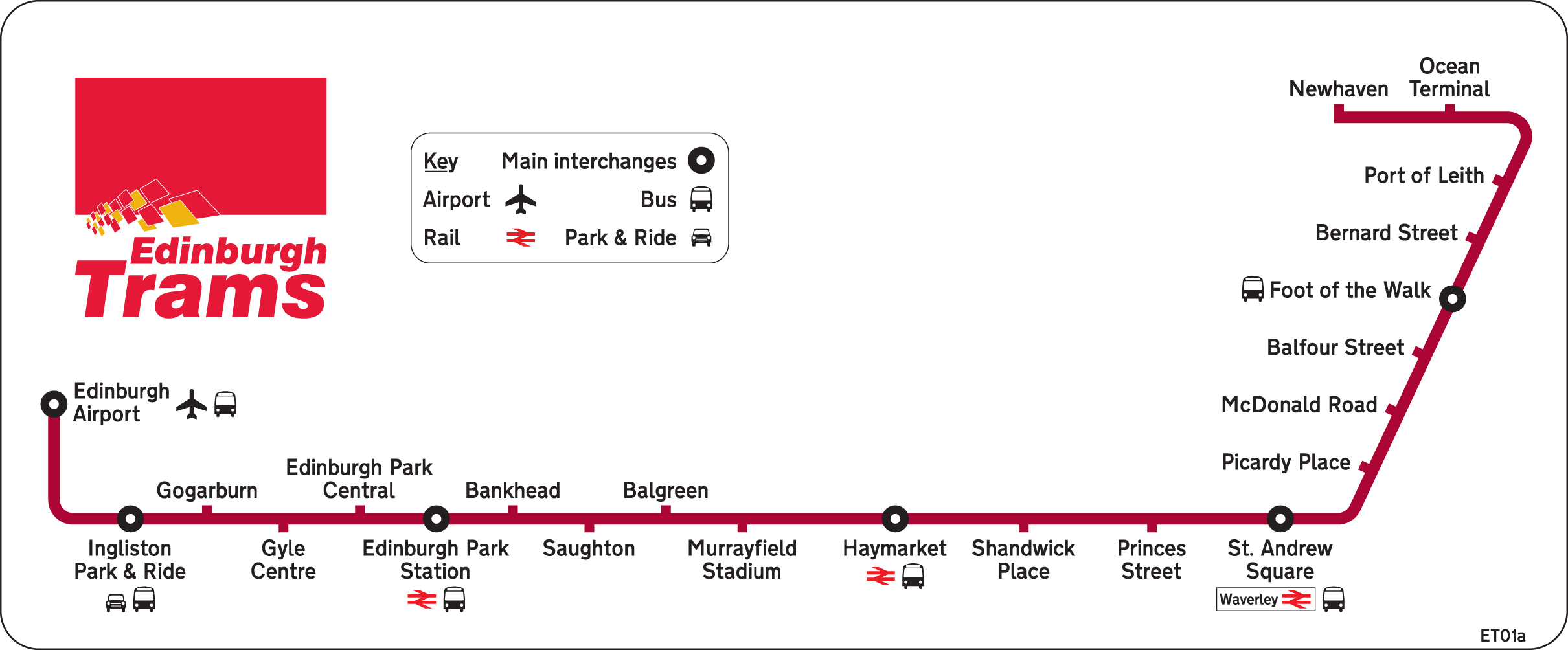
2007 reduced plans: Phase 1a only - Airport to Leith 
Tram route: As delivered 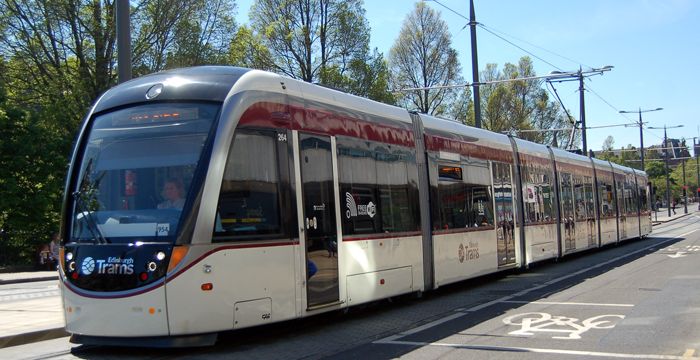
|
Comments on the proposals are welcome and should be sent to: admin@eisl.org.uk